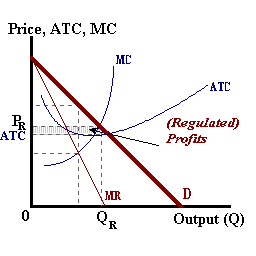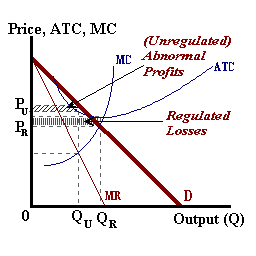
At the other end of the competitive spectrum is Monopoly where there is only one firm in a given industry. Consumers in this market have no choice but to buy from that one firm or not at all. For this reason, the monopolist is known as a price-maker one that can set prices at any desired level. Monopolies occur largely due to the existence of barriers to entry in a given industry. These barriers include:
With these barriers, the monopolist is able to set a level of output consistent with the rule of profit maximizing:
MR = MC
Since the monopolizing firm is the only firm in the industry, the market demand curve is also the demand curve facing the firm.

With a typical downward sloping demand curve we find that:
P > MR for Q > 0
and under conditions of profit maximization,
P > MC given MR = MC
thus this profit-maximizing level of output is less than would be the case if output decisions were based on P = MC.
This reduced level of output is considered to represent an inefficient level of output in that the price consumers are willing to pay for one more of output (a measure of the benefits received from consuming that last unit) is greater than the opportunity costs of producing an additional unit. Social welfare could be improved allocating resources to the production of this good and making more of it available to consumers. As production and sale of this good increases, the price consumers are willing to pay for each additional unit declines (diminishing marginal utility). In addition, with increased production cost will rise (increasing opportunity costs). Eventually output will increase until P = MC and an efficient allocation of resources is realized.
If it is the case that profit-maximizing behavior results in abnormal profits (i.e., P > ATC), then given these barriers to entry, the profits will persist. Profit-maximizing behavior results in an equilibrium condition with no incentive for the firm to alter the level of output.
Regulation of a monopolist (in the case of natural monopolies), is based on the condition for market efficiency leading to greater level of output and lower prices relative to prices based on profit maximizing behavior: P = MC

As stated above, this efficiency condition equates the benefits of consuming an additional unit of output (as measured by the price the consumer is willing to pay for the unit) to the costs of producing that additional unit (these costs actually represent the opportunity cost of production -- the next best use of the factor inputs).
Sometimes, however, this Marginal Cost pricing leads to losses for the monopolist. These losses will eliminate any incentive for the monopolist to remain in business. Because this particular firm is the only producer of the good in question, going out of business implies that the product will not be available to the consumer. Thus an alternative pricing scheme in these cases is to regulate the firm based on Average Cost pricing where output levels are determined by the condition: P = ATC

In this case, the firm will be allowed to earn a normal rate of profit and produce a level of output slightly below that of an efficient level.
|
|